Vascular Plants of the Gila Wilderness
Presented in Association with the
Western New Mexico University Department
of Natural Sciences
Weissia phascopsis R.H. Zander
Family: Pottiaceae
Status: Native
Synonyms:
Gymnostomum phascoides Drummond
Astomum phascoides (Drummond) Grout
Hymenostomum rostellatumvar. phascoides (Drummond) Cardot
Weissia rostellata var. phascoides (Drummond) W. D. Reese & B. A. E. Lemmon
Weissia phascopsis is easily overlooked and erroneously assumed to be W. controversa. The cells of the long lanceolate leaves of each of them are pluripapillose and have strongly incurved margins distally. The biggest
difference between these two is that W. phascopsis is cleistocarpous, meaning that its oval capsule does
not open spontaneously but rather irregularly ruptures to open. The long-rostrate operculum is persistent,
it does not fall from the capsule and there are no peristome teeth. Although less reliable a characteristic, the 3-5 cell
mucro of W. phascopsis is usually more stout than that of W. controversa which usually consists of 1-3 cells. We are grateful to John C. Brinda for sharing this specimen with us.
Please click on an image for a larger file.
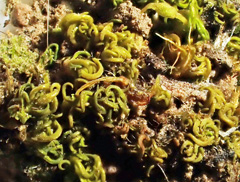
Weissia phascopsis, photo Russ Kleinman & Karen Blisard, specimen collected and determined by
John C. Brinda, Doña Ana County, Organ Mountains, Lower Fillmore Canyon, March 23, 2010
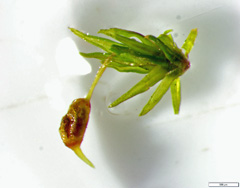
Weissia phascopsis, single reproductive plant, photo Russ Kleinman & Karen Blisard, specimen collected and determined by John C. Brinda, Doña Ana County, Organ Mountains, Lower Fillmore Canyon, March 23, 2010
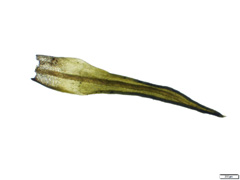
Weissia phascopsis, photomicrograph of leaf, photo Russ Kleinman & Karen Blisard, specimen collected and determined by John C. Brinda, Doña Ana County, Organ Mountains, Lower Fillmore Canyon, March 23, 2010
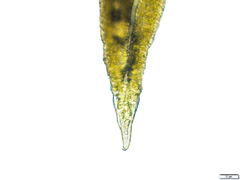
Weissia phascopsis, photomicrograph of stout mucro, photo Russ Kleinman & Karen Blisard, specimen collected and determined by John C. Brinda, Doña Ana County, Organ Mountains, Lower Fillmore Canyon, March 23, 2010
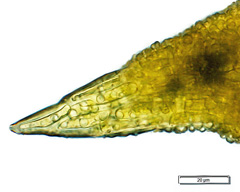
Weissia phascopsis, photomicrograph of stout mucro, photo Russ Kleinman & Karen Blisard, specimen collected and determined by John C. Brinda, Doña Ana County, Organ Mountains, Lower Fillmore Canyon, March 23, 2010
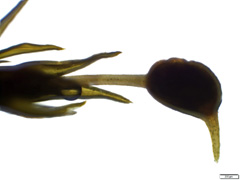
Weissia phascopsis, photomicrograph of mature sporophyte, photo Russ Kleinman & Karen Blisard, specimen collected and determined by John C. Brinda, Doña Ana County, Organ Mountains, Lower Fillmore Canyon, March 23, 2010
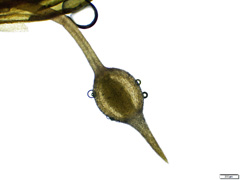
Weissia phascopsis, photomicrograph of immature sporophyte, photo Russ Kleinman & Karen Blisard, specimen collected and determined by John C. Brinda, Doña Ana County, Organ Mountains, Lower Fillmore Canyon, March 23, 2010
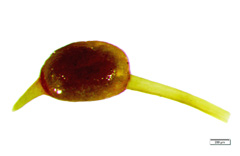
Weissia phascopsis, photomicrograph of mature sporophyte, photo Russ Kleinman & Karen Blisard, specimen collected and determined by John C. Brinda, Doña Ana County, Organ Mountains, Lower Fillmore Canyon, March 23, 2010
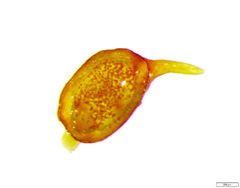
Weissia phascopsis, photomicrograph of bissected mature sporophyte demonstrating no peristome teeth and indehiscent
operculum, photo Russ Kleinman & Karen Blisard, specimen collected and determined by John C. Brinda, Doña Ana County, Organ Mountains, Lower Fillmore Canyon, March 23, 2010
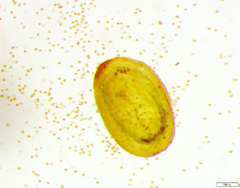
Weissia phascopsis, photomicrograph of other half of bissected mature sporophyte shown above, photo Russ Kleinman & Karen Blisard, specimen collected and determined by John C. Brinda, Doña Ana County, Organ Mountains, Lower Fillmore Canyon, March 23, 2010
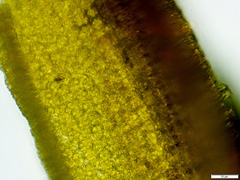
Weissia phascopsis, photomicrograph of cells at midleaf showing papillae, photo Russ Kleinman & Karen Blisard, specimen collected and determined by John C. Brinda, Doña Ana County, Organ Mountains, Lower Fillmore Canyon, March 23, 2010
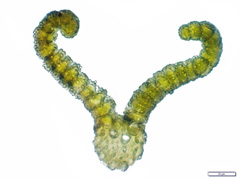
Weissia phascopsis, photomicrograph of leaf cross section showing incurved margin, photo Russ Kleinman & Karen Blisard, specimen collected and determined by John C. Brinda, Doña Ana County, Organ Mountains, Lower Fillmore Canyon, March 23, 2010
Back to the Index











